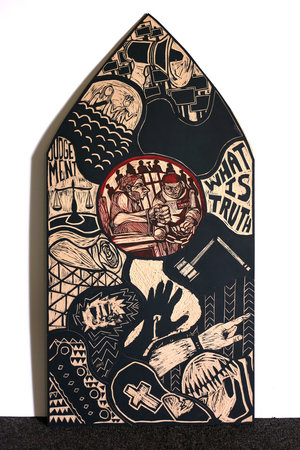Spacial awareness is a skill I have not yet mastered. Living in, Bronx, New York, in a neighborhood with people, who for the most part look like me, never led me to ask myself about how I took up space.
But what do I mean, when I talk about “taking up space?” Do I mean the fundamental physicalities of one’s body being in a particular environment? Do I mean the presence, impact and influence that someone leaves on their community, their society? Could I mean both? When I think about how I take up space now, I am more aware of my mannerisms, my choice to speak in certain environments, how much room I create for others, and what influences I place on the world outside of me.
The dance lecture from Dr. Broomfield paired with Professor Amanda Roth’s Philosophy of Women’s course had helped me to ask myself how do I take up space as an African American young women. These experiences have made me reflect on how personal themes connect to the work and artwork of Steve Prince, a printmaker, educator and evangelist from New Orleans, Louisiana, and the man of subject in the INTD 288 class marked The Art of Steve Prince.
When Steve Prince came on residency to Geneseo it was clear that he was a man who took up as much as he could, and to add, he felt comfortable in that space. Me however not so much. For instance I constantly contemplate my position in this secondary institution. Being in a class or social setting where I am constantly second guessing the words that I am using in order to explain myself is exhausting, but it’s what i’ve been doing my entire life to some degree . There is always that doubt of not being competent or not having a certain “level” of competence as my peers.
As an African American college student, in a school that is predominately white there is a lot of unfamiliarity that makes me uncomfortable at times. There are moments when I notice i’m the only African American person in a room, or when in a meeting, or in a group. Race is the first difference that I notice but why is that? Why don’t I feel comfortable in certain spaces. Why do I create more space for others and allow myself to me shrunken down. When discussed in the context of both classes, we talk about the internalization and the teachings of subordination. In my philosophy class we had an introduction to the patriarchal world that has manifested itself into American society, it has also lead women to be at the feet of and to upmost practice the passive individual.
Growing up as a black young woman in a patriarchal society, where at the top white men rest, is something that I have well been aware of to an extent.
Growing up as child I had not fantasized about being a white person for no reason, I had done so because they were the ones in the magazines, on tv, and in person were the ones seen as beautiful, intelligent, and desirable. But if women were at the bottom of patriarchy, then where does that leave other groups who are non-white and why would I want to be a cog in such a machine? Why would I want to take up that societal space?.
Young women are trained to take up less space. African Americans were told to be nonexistent, i.e. to not be seen when company comes but do the work anyways. So where does that leave the African American women and every intersectional group that has been excluded from this narrative of demand, command, and power?
I enjoy the artworks of Steve Prince because he is able to address the lasting influences of such a system and the unjust, subordinating spaces in which African Americans are forced to fill . For instance Prince’s piece “Nine Little Indians” tells a story of the Little Rock 9 a reference to to the 9 African American children in 1957 Arkansas, who integrated the public school system. Generally speaking, school systems now are a result of the effort to push integration and diversity by many before us. This lack exposure of one group of people to another, and because of historical context, specifically segregation, slavery, all of these important aspects have and still influence the modern world we see now. Those events are the reasons why i’m the only African American in room full of 30. Of why sometimes I choose to give more room to others, and play to the nonexistent role.
Beyond all the horrible institutional and patriarchal systems, there is still a choice in which I am given, where I have to be forceful and willing to disrupt the cycle. Attending SUNY Geneseo, a predominantly white institution (PWI), has given me the opportunity to actively exercise that ability to stir change . Being here I plan to start taking up as much space as I can. I want to work on breaking the stifling cycles of the past, and recognizing that it can only be accomplished by talking about the world, and working against those factors meant to suppress, To continue resisting, and fighting.

